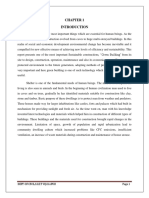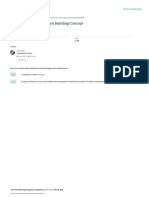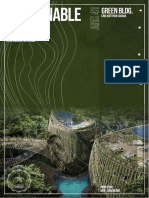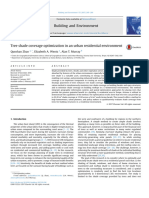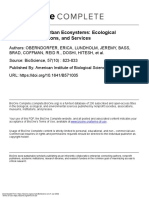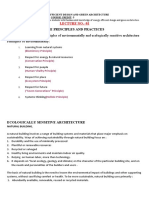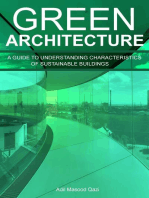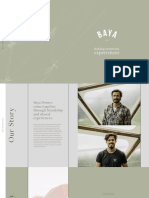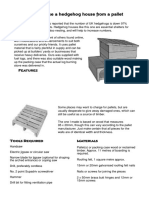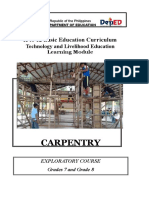QW 1
QW 1
Uploaded by
Kimy Jane PegoriaCopyright:
Available Formats
QW 1
QW 1
Uploaded by
Kimy Jane PegoriaOriginal Title
Copyright
Available Formats
Share this document
Did you find this document useful?
Is this content inappropriate?
Copyright:
Available Formats
QW 1
QW 1
Uploaded by
Kimy Jane PegoriaCopyright:
Available Formats
Sustainable architecture often incorporates the use of recycled or secondhand materials, such 2.
2. Sustainable Design for the walls- The walls of
as reclaimed lumber and recycled copper. The reduction in the use of new materials creates a sustainable development need to withstand climatic
corresponding reduction in embodied energy (energy used in the production of materials). changes and extreme conditions. Therefore, using
Often sustainable architects attempt to retrofit old structures to serve new needs in order to materials that allow the natural breeze to flow
avoid unnecessary development. Architectural salvage and reclaimed materials are used when through and the water on the surface to run down
appropriate. When older buildings are demolished, frequently any good wood is reclaimed, smoothly without affecting the integrity of your
renewed, and sold as flooring building is a huge necessity.
Examples of sustainable building materials encompass recycled denim or blown-in fiberglass
insulation, sustainably harvested wood, Trass, Linoleum sheep wool, hempcrete, roman 3. Eco-friendly interior design- Consider the reuse of wood
concrete, panels composed of paper flakes, baked earth, rammed earth, clay, vermiculite, flax pellets to build DIY furniture, install pieces made of
linen, sisal, seagrass, expanded clay grains, coconut, wood fiber plates, calcium sandstone, reclaimed wood, and open up the interiors for better air
locally sourced stone and rock, and bamboo, renowned for its strength and rapid growth as a circulation and natural light.You can use natural wood for
woody plant. Additionally, non-toxic low-VOC glues and paints are utilized. Bamboo flooring is your flooring, decks, etc. you can also incorporate a rock
beneficial in eco-friendly environments as it aids in the reduction of airborne pollutant particles. garden in the exterior pathway leading up to the house.
Implementing a vegetative cover or a protective screen over building envelopes also serves the Sustainable options such as houseplants and succulents are
same purpose. Paper made from forest wood is purportedly fully recyclable, thereby also excellent additions.
replenishing and conserving nearly all the wood source during its production. The built
environment has significant untapped potential for effectively and systematically storing
carbon.
Components of Sustainable Architecture
To understand what sustainable architecture is, let us discuss the main components that every 4. Natural ventilation- is the flow of air between
sustainable development needs to have. Regardless of whether it is a residential property or a the outside and the inside of the building. Natural
commercial skyscraper, you can incorporate these elements and reduce the carbon footprint of ventilation originates from two natural forces:
your design. pressure differences created by the wind around
the building – wind-driven ventilation; and
5 Sustainable Architecture Design Ideas
temperature differences – 'stack effect'
1. Installing green roofs- a green roof is many things. It supports rainwater ventilation.
harvesting by gliding the falling water off of slanted surfaces. It is a space
that celebrates the conjugation of the natural environment and man-made
design, and it presents an opportunity for social interactions. You can 5. Efficient heating and cooling system - A
instigate a terrace garden if you have an open plan, line it with plants and sustainable wood installation for the sides of a
succulents for ridding the air of pollutants. Consider incorporating a seating building helps the building design interact freely
area in your architectural design for social gatherings. with the ecosystem. The solar shading options
also help with the heating and cooling milieu
reducing the overall carbon footprint to a bare
minimum. Sustaining humankind on solar energy
is the next big thing for power conservation
which makes this an apt methodology for your
existing buildings and new sustainable
developments.
STUDENT NAME: INSTRUCTOR DATE
PROJECT TITLE: STUDENT NO. RATING
PEGORIA, KIMY JANE S. AR. PRINCE CARLO BAUTISTA Nov 24,2023
RESEARCH 01
SUBJ. CODE & TITLE: SCHEDULE SHEET NO.
SUSTAINABILITY IN DESIGN 202011051
AND ITS APPLICATIONS AD 40187 -ARCHITECTURAL DESIGN 7 MONDAY -AD LEC 7 5-6PM 02
Timber Crete- is an interesting building
The utilization of resources is restricted to recycled materials, renewable materials, and materials material made from a mix of sawdust and
certified by forest man agreement, to minimize their ecological footprint and adhere to the concrete. It is lighter than concrete and reduces
principles outlined in the Sustainable Development Goals (SDGs). To adhere to low-carbon transportation emissions. The sawdust also
regulations, the reuses a waste product and replaces some of
building process must be feasible for students to execute independently, without the need for the energy-intensive components of traditional
extensive machinery or equipment. Furthermore, it is advisable to emphasize the notion of the concrete. Plus, timber concrete could also be
circular economy within the practical course. This can be achieved through the utilization of formed into traditional shapes like pavers,
reusable materials and manufacturing techniques, as well as the reduction of disposable materials bricks and blocks.
and products. These measures aim to foster resource recycling and facilitate the sustainable
advancement of the economy. The hands-on course can effectively align with sustainable. Solar Panels- technology advances and designs grow more.
development goals and contribute to positive environmental and societal outcomes through the visually acceptable, solar panels are used increasingly frequently
adoption of sustainable materials, waste reduction strategies, low-carbon footprint techniques, on roofs and yards. A residence can reduce its reliance on
consideration of sustainable development goals' impacts, and the integration of circular economy nonrenewable energy using solar panel tiles or mounted.
principles. structures.
Sustainable product design entails making environmentally responsible choices for the betterment Composite roofing shingles -common roof tile types
of the globe. It involves selecting materials that are compatible with your design, align with your like asphalt shingles and wood shakes that
carbon footprint goals, pose no harm during usage, and can be reused. constantly rising, cracking, and fading can become
energy drains in terms of enabling air and moisture
Bamboo- is considered one of the best eco-friendly building materials. Has a high strength-to-weight to enter and exit the home just because they need
ratio. In fact, with a tensile strength of 28,000 pounds per square inch (PSI), bamboo is even so much upkeep. Composite roofing shingles would
stronger than steel (23,000 PSI) and 2 to 3 times stronger than hardwoods like oak. be a better option because they maintain the natural
appearance of more conventional materials while.
requiring less upkeep.
Lumber- is wood that has been processed into
uniform and useful sizes, including beams and
planks or boards. Lumber is mainly used for.
construction framing, as well as finishing. Lumber
has many uses beyond home building.
Precast Concrete Slabs- are used for walls and building
facades as they hold up well to all sorts of weather,
while others can be used for floor and flat roofs. Concrete is a composite material composed of
aggregate bonded together with a fluid cement
Using concrete slabs is an excellent way of controlling that cures over time. Concrete is the
heat within a building and is affordable as a building second-most-used substance in the world after
material. Plus, the sustainability of precast concrete water and is the most widely used building.
slabs are higher than many traditional concrete material.
options, as the slabs often take much less energy to
produce and assemble.
STUDENT NAME: INSTRUCTOR DATE
PROJECT TITLE: STUDENT NO. RATING
PEGORIA, KIMY JANE S. AR. PRINCE CARLO BAUTISTA Nov 28,2023
RESEARCH 02
SUBJ. CODE & TITLE: SCHEDULE SHEET NO.
SUSTAINABILITY IN DESIGN 202011051
AND ITS APPLICATIONS AD 40187 -ARCHITECTURAL DESIGN 7 MONDAY -AD LEC 7 5-6PM 02
Sustainable design optimizes building performance and minimizes
negative impacts on building occupants and the environment.
We incorporate sustainable design and energy efficiency principles
into our construction and modernization projects, balancing cost,
environmental, societal, and human benefits that help meet our
tenant agencies' mission objectives and functional needs.
Sustainable design principles aim to:
• Optimize site potential.
• Minimize non-renewable energy consumption and waste.
• Use environmentally preferable products.
• Protect and conserve water.
• Improve indoor air quality.
• Enhance operational and maintenance practices.
• Create healthy and productive environments.
Implementing sustainable design principles facilitates the development of enduring solutions, enabling societies to safeguard the
welfare of their populace and foster a harmonious coexistence with the natural environment across
successive generations.
Designers employ strategies to mitigate waste generation by developing goods that possess recyclability, composability,
and, ideally, perpetual reusability. Additionally, they can develop a manufacturing procedure to mitigate or eliminate carbon
dioxide emissions. One of the most prominent challenges of our era pertains to environmentalism and climate change.
mitigation. Consequently, numerous designs are closely associated with addressing these issues.
STUDENT NAME: INSTRUCTOR DATE
PROJECT TITLE: STUDENT NO. RATING
PEGORIA, KIMY JANE S. AR. PRINCE CARLO BAUTISTA Nov 28,2023
RESEARCH 02
SUBJ. CODE & TITLE: SCHEDULE SHEET NO.
SUSTAINABILITY IN DESIGN 202011051
AND ITS APPLICATIONS AD 40187 -ARCHITECTURAL DESIGN 7 MONDAY -AD LEC 7 5-6PM 01
You might also like
- Carpentry 9 Q1 Module 1Document22 pagesCarpentry 9 Q1 Module 1GREGORIO ALVAREZ100% (29)
- Green BuildingDocument60 pagesGreen BuildingRamnaresh Sharma86% (7)
- Seminar ReportDocument26 pagesSeminar ReportSana Loni100% (2)
- Green Roof and Living Wall For Architecture PDFDocument48 pagesGreen Roof and Living Wall For Architecture PDFSamnangPhonNo ratings yet
- Bills of Quantities KMTC For 4no Classrooms PDFDocument18 pagesBills of Quantities KMTC For 4no Classrooms PDFabdul100% (1)
- Green Architecture and Sustainable DevelDocument4 pagesGreen Architecture and Sustainable DevelMichael OrtigasNo ratings yet
- Green Building For Public MarketDocument5 pagesGreen Building For Public MarketvirgilioNo ratings yet
- Green ArchitectureDocument12 pagesGreen ArchitectureJosielyn ArrezaNo ratings yet
- Green Buildings A ReviewDocument5 pagesGreen Buildings A ReviewSamar OmaraNo ratings yet
- Green Technology-A Review: S. M. Dhawade, S. M. HarleDocument5 pagesGreen Technology-A Review: S. M. Dhawade, S. M. HarleerpublicationNo ratings yet
- Sustainable Concept Canada Research Green Bldg. Arc41Document10 pagesSustainable Concept Canada Research Green Bldg. Arc41Matthew CanadaNo ratings yet
- Green ArchitectureDocument20 pagesGreen ArchitectureIbie Scandie Shain Quiman100% (1)
- Electives IIDocument20 pagesElectives IIsunit waghmareNo ratings yet
- Department of Civil Engineering, Amity School of Engineering & Technology, Amity University HaryanaDocument1 pageDepartment of Civil Engineering, Amity School of Engineering & Technology, Amity University HaryanaKarthik NayakNo ratings yet
- Cat 2 Question BankDocument23 pagesCat 2 Question BankAmaira NaqviNo ratings yet
- Sustainable Architecture Topic-Sustainable MaterialsDocument9 pagesSustainable Architecture Topic-Sustainable MaterialsADITYANo ratings yet
- Design ConceptDocument5 pagesDesign ConceptRenniel Kent Oya-anNo ratings yet
- Zhao 2017 - Tree Shade Coverage Optimization in An Urban Residential EnvironmentDocument12 pagesZhao 2017 - Tree Shade Coverage Optimization in An Urban Residential EnvironmentArnela PolićNo ratings yet
- What Is Green Construction?Document4 pagesWhat Is Green Construction?Slesha PantaNo ratings yet
- Green Roofs As Urban Ecosystems: Ecological Structures, Functions, and ServicesDocument13 pagesGreen Roofs As Urban Ecosystems: Ecological Structures, Functions, and Servicesjohnmw26No ratings yet
- Green ArchitectureDocument25 pagesGreen Architectureshadan khanNo ratings yet
- Green ArchitectureDocument8 pagesGreen ArchitectureJester CogolloNo ratings yet
- Green BuildingDocument10 pagesGreen Buildingmr_mrsNo ratings yet
- Sustainability Fact Sheet FebruaryDocument2 pagesSustainability Fact Sheet FebruaryBogdan BukaraNo ratings yet
- Sustainable Architecture: Guided by - Deepali Hejiib Presented by - Rucha Khalikar Shivani DeshmukhDocument12 pagesSustainable Architecture: Guided by - Deepali Hejiib Presented by - Rucha Khalikar Shivani Deshmukhrucha KhalikarNo ratings yet
- Sustainable ArchitectureDocument26 pagesSustainable Architecturecyarakk100% (5)
- Building The FutureDocument36 pagesBuilding The FuturekaleabhiwotNo ratings yet
- Sustainable Principles and PracticesDocument11 pagesSustainable Principles and Practicesanubhav dasguptaNo ratings yet
- Identification of Local & Sustainable Building Methods For Residences in KeralaDocument9 pagesIdentification of Local & Sustainable Building Methods For Residences in KeralaathulyaNo ratings yet
- Enviro Friendly HousingDocument16 pagesEnviro Friendly HousingRick3862No ratings yet
- Finnal Innovative Materials For Green Building ConstructionDocument8 pagesFinnal Innovative Materials For Green Building Constructionl236729No ratings yet
- Case Study Green Rated Building - Patni (i-GATE) Knowledge Center, NoidaDocument9 pagesCase Study Green Rated Building - Patni (i-GATE) Knowledge Center, NoidaMohd Amaan Sheikh75% (4)
- 2-Building For The Future 1 2 2941-7171Document15 pages2-Building For The Future 1 2 2941-7171Rakiya NaseerNo ratings yet
- Key Elements of Green DesignDocument52 pagesKey Elements of Green DesignthierrydescampsNo ratings yet
- Materials NotesDocument6 pagesMaterials NotesEr Lav Kush PrasadNo ratings yet
- Luego - Bsarch-3a - Research-No.01 (Sustainability)Document5 pagesLuego - Bsarch-3a - Research-No.01 (Sustainability)Luego, Brent Jarryd P.No ratings yet
- Report On Green Architecture: Bachelor of Architecture Tenth Semester (2019-2020)Document27 pagesReport On Green Architecture: Bachelor of Architecture Tenth Semester (2019-2020)Zaid Beg100% (1)
- SUSTAINABLE BUILDINGS-Assignment 02Document16 pagesSUSTAINABLE BUILDINGS-Assignment 02Naitik JaiswalNo ratings yet
- Improvement of Thermal Insulation by Environmental Means..Document14 pagesImprovement of Thermal Insulation by Environmental Means..syakoNo ratings yet
- The Basic of Green ArchitectureDocument23 pagesThe Basic of Green ArchitectureRhpu CorNo ratings yet
- Green Architecture Research Paper - Theory 1Document25 pagesGreen Architecture Research Paper - Theory 1teacabungcalNo ratings yet
- Grupo 3 - Diapositivas - Mitigacion Olas de CalorDocument17 pagesGrupo 3 - Diapositivas - Mitigacion Olas de CalorȻassian GrimesNo ratings yet
- Architecture, Green Design & Sustainability - Concepts and Practices (R.N. Lacroix, 2007)Document10 pagesArchitecture, Green Design & Sustainability - Concepts and Practices (R.N. Lacroix, 2007)Razi MahriNo ratings yet
- Architectural Seminar Topics: Professional Practice 4Document6 pagesArchitectural Seminar Topics: Professional Practice 4FELICITY MONTEFALCONo ratings yet
- International Journal of Design & Nature and Ecodynamics: Received: 27 December 2019 Accepted: 18 March 2020Document6 pagesInternational Journal of Design & Nature and Ecodynamics: Received: 27 December 2019 Accepted: 18 March 2020RehnaNo ratings yet
- Green BuildingDocument152 pagesGreen BuildingMade Adi WidyatmikaNo ratings yet
- Green Building Materials-2Document9 pagesGreen Building Materials-2Abhiram P RNo ratings yet
- NARRATIVE Report - Architectural DesignDocument6 pagesNARRATIVE Report - Architectural DesignVanessa OchavilloNo ratings yet
- Lecture 3Document31 pagesLecture 3Fire breatherNo ratings yet
- Translucent BricksDocument7 pagesTranslucent BricksJakka hitheshiniNo ratings yet
- C19 WSEAS2007 562 079 ArchGreenDesSustDocument10 pagesC19 WSEAS2007 562 079 ArchGreenDesSustRV PasicaranNo ratings yet
- Green Building Thesis StatementDocument5 pagesGreen Building Thesis StatementWebsiteThatWillWriteAPaperForYouSavannah100% (1)
- Gallego Bsesoc3a M6Document2 pagesGallego Bsesoc3a M6dylyn jane gallegoNo ratings yet
- Task 4. Modern Green Architecture (Green Roofs, Vertical Greenery)Document8 pagesTask 4. Modern Green Architecture (Green Roofs, Vertical Greenery)Moon NaemNo ratings yet
- 2ar8 TD Presentation - Ang - Manto - Querido - Raqueno - TahilDocument17 pages2ar8 TD Presentation - Ang - Manto - Querido - Raqueno - TahilISABELLE MAXINE MANTONo ratings yet
- Design Guidelines For Green RoofsDocument22 pagesDesign Guidelines For Green RoofsGraceNo ratings yet
- Green BuildingDocument5 pagesGreen BuildingDennis DaltonNo ratings yet
- Ijirt148434 PaperDocument13 pagesIjirt148434 PaperShantilal ANo ratings yet
- 16paper 5 - 2008 Seaoc Convention - Structural Implications of Green Roofs Terraces and Walls by Seaosc SDC 7-7-08Document21 pages16paper 5 - 2008 Seaoc Convention - Structural Implications of Green Roofs Terraces and Walls by Seaosc SDC 7-7-08Forsythe LearningNo ratings yet
- Literature Review - Sharon ShiDocument3 pagesLiterature Review - Sharon Shiapi-654544793No ratings yet
- Group 2 Concept BoardDocument1 pageGroup 2 Concept BoardJHANLYN ZAYASNo ratings yet
- Green Architecture: A Guide To Understanding Characteristics of Sustainable BuildingsFrom EverandGreen Architecture: A Guide To Understanding Characteristics of Sustainable BuildingsNo ratings yet
- Midterm ExamDocument2 pagesMidterm ExamKimy Jane PegoriaNo ratings yet
- Research Design Lec 1Document2 pagesResearch Design Lec 1Kimy Jane PegoriaNo ratings yet
- BT5 (Week 05)Document59 pagesBT5 (Week 05)Kimy Jane PegoriaNo ratings yet
- ReportDocument4 pagesReportKimy Jane PegoriaNo ratings yet
- MADM In-Class QuizDocument11 pagesMADM In-Class QuizPiyush SharmaNo ratings yet
- Prijslijst LUMBER KOOYMAN BONAIREDocument2 pagesPrijslijst LUMBER KOOYMAN BONAIREmasclineNo ratings yet
- A Hive Stand: "In The Beekeeper's Work Shop"Document7 pagesA Hive Stand: "In The Beekeeper's Work Shop"Dinu DavidNo ratings yet
- Bayastay Brochure - 2021Document14 pagesBayastay Brochure - 2021Nicholas ZoppaNo ratings yet
- Hedgehog House PlanDocument9 pagesHedgehog House PlanOriol TraveNo ratings yet
- Plans PDFDocument7 pagesPlans PDFAngelo MoralNo ratings yet
- BUILDING MATERIALS AND ASSEMBLIES (Handout) - BSCE-3BDocument24 pagesBUILDING MATERIALS AND ASSEMBLIES (Handout) - BSCE-3BArianne Mae De Vera GallonNo ratings yet
- Framing - House ConstructionDocument64 pagesFraming - House Construction오상진100% (1)
- APA - Design of Structural Glued Laminated Timber ColumnsDocument20 pagesAPA - Design of Structural Glued Laminated Timber ColumnsLJD211No ratings yet
- Glu Hand Volume-1Document144 pagesGlu Hand Volume-1Frank N. / Design Eng.No ratings yet
- Building-Technology-Notes WOOD TO CEMENTDocument12 pagesBuilding-Technology-Notes WOOD TO CEMENTJohn Milan Octeza100% (2)
- The Hudson Product Catalogue PDFDocument10 pagesThe Hudson Product Catalogue PDFLivingSeed AustraliaNo ratings yet
- CIVL 392 - Chapter 6 - FormworkDocument69 pagesCIVL 392 - Chapter 6 - FormworkGerold MolinaNo ratings yet
- WOOD (Compatibility Mode)Document31 pagesWOOD (Compatibility Mode)BackupFilesNo ratings yet
- Aicher - Hybrid Beech and Spruce CLTDocument2 pagesAicher - Hybrid Beech and Spruce CLTUlrich HübnerNo ratings yet
- Structuri LemnDocument97 pagesStructuri LemnRoxana R. DespotovicsNo ratings yet
- Kansas SawmillsDocument6 pagesKansas SawmillsGregg HockettNo ratings yet
- Timber Foundation Pilng-GrahamDocument14 pagesTimber Foundation Pilng-GrahamSankar CdmNo ratings yet
- Timber and Materials - Wood Technology EWP NotesDocument19 pagesTimber and Materials - Wood Technology EWP NotesFaith Gwamure JafariNo ratings yet
- Earthquake Resistant Building ConstructionDocument3 pagesEarthquake Resistant Building ConstructionKristine SantosNo ratings yet
- Installation Specification For Driven PilesDocument38 pagesInstallation Specification For Driven PilesSuryanto TjiongNo ratings yet
- Carpentry LessonDocument118 pagesCarpentry LessonJessica RebodosNo ratings yet
- Post & Beam Glulam Hand HewnDocument2 pagesPost & Beam Glulam Hand HewnMark Kenneth P. OntejoNo ratings yet
- WoodDocument8 pagesWoodarmaya sansNo ratings yet
- Saw Survey QDocument6 pagesSaw Survey Q1man1bookNo ratings yet
- Pfeifer Group PDF Schalungstraeger Infoblatt enDocument6 pagesPfeifer Group PDF Schalungstraeger Infoblatt enRene D. ArrietaNo ratings yet
- Portal Frame Structure: Construction - ViDocument8 pagesPortal Frame Structure: Construction - ViRahul RaghavNo ratings yet
- Pier DetailDocument36 pagesPier DetailkingdbmNo ratings yet


